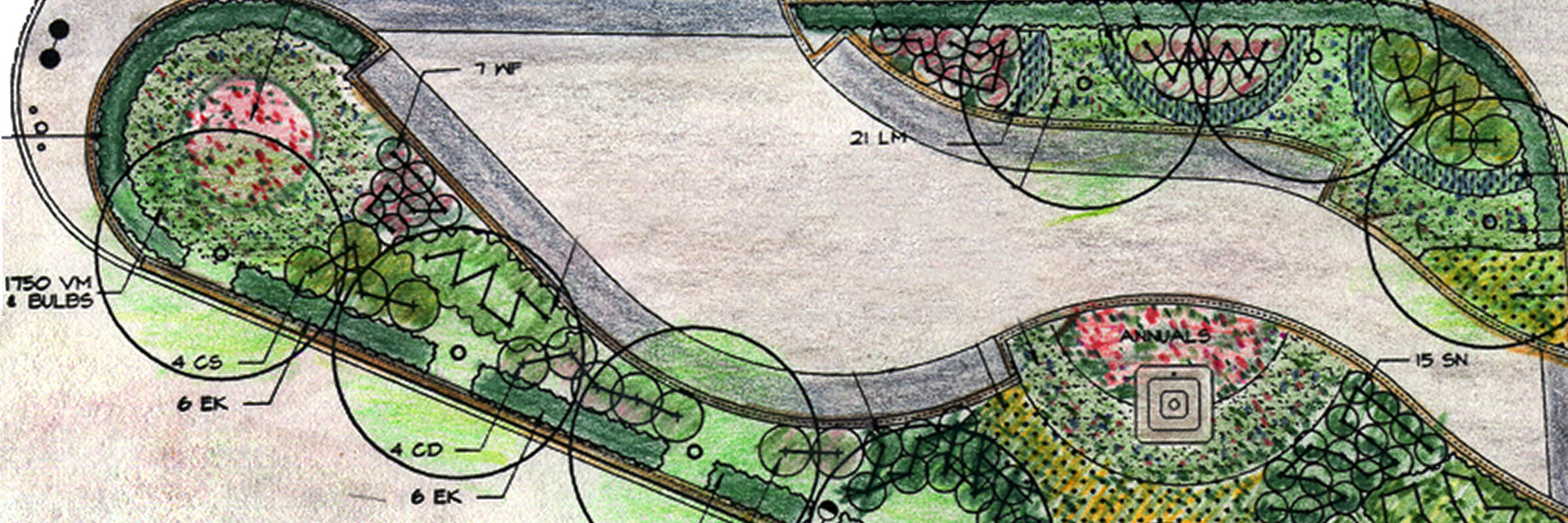
Our tiny and mighty treasure historic overview: Duane Park Timeline
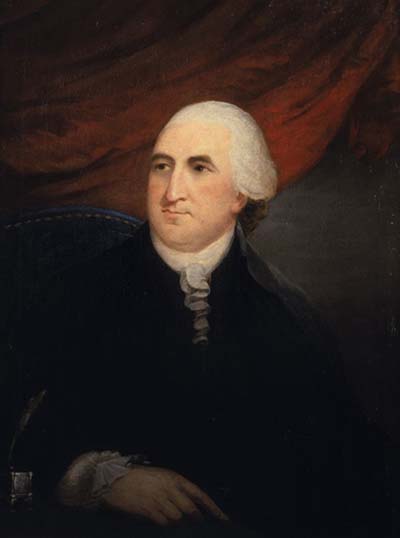
Duane Park is the second oldest public park in New York City (trailing Bowling Green), located in the middle of Duane Street as it widens to meet Hudson St. It was set aside as public land by the city government of 1797, which bought it from the vestry of Trinity Church (Wall St.). The street and park are named for James Duane, a leading figure in the Revolutionary War, delegate to the constitutional convention, judge of the United States District Court, and first mayor of New York after independence.
As the city laid out the streets of the neighborhood in 1794, Duane St. turned out to be inconveniently wide at the point where it intersected a grid with a slightly different axis. The triangle that occurred was too small for building, too big for a street. Three years later, this tiny remnant of Trinity Church’s “Lower Farm” tract became Duane Park. Not a park in the sense of Central, Golden Gate, or Lincoln Parks, it is a very, very, very early example of what has come to be known as a “neighborhood park,” a little green spot that breaks the relentlessness of an urban landscape.
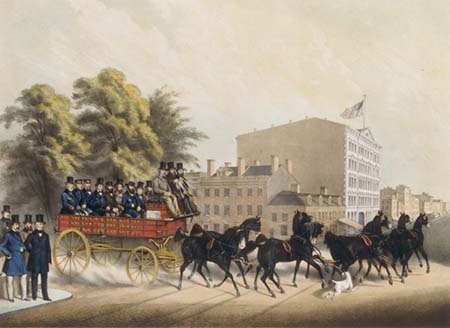
At the time of the purchase in 1797 the neighborhood was primarily residential, the leading edge of northern expansion of a city growing away from its deep downtown roots. Houses, stables, churches, and schools (not least, Columbia College, of which Mr. Duane was a trustee) dotted the area, and it is not surprising that in 1804 this small triangle was planted as a formal garden with triangular and circular beds ornamented with trees and enclosed by an iron fence. In 1825, more “forest trees” were added and grew to full and feathery height, as we can see in an 1858 print of an American Express wagon and its magnificent team of horses (driven by both Henry Wells and William Fargo, the founders) passing along Duane St.
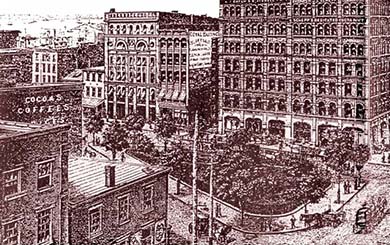
By the time Wells and Fargo were depicted dashing along Duane Street, the neighborhood was deep into change. The wave of northern search for fresh air and bowery surroundings had long passed over it, leaving houses converted into warehouses and new, bulky brick structures, home to the relentless commerce of a growing city. A horse-drawn railway went up Hudson Street and the first elevated railroad tracks in America darkened nearby Greenwich St. and West Broadway. The little park also went into decline; an 1871 report notes that “The Duane Street Park possessed a half-destroyed fence and was in a state of dilapidation.” Taking note of the disrepair, the city undertook a facelift, resulting in “an elegant little triangular spot, filled with deciduous trees, evergreens, and shrubs.” In keeping with the norm for urban picturesque landscape, it was wholly fenced around, with sidewalks on all three sides. Like an engraving, it was something you could peer at but not get into.
In 1886 a newly elected reformist mayor, Abram Hewitt, proclaimed that all New York City parks should be more like Central Park or Prospect Park in Brooklyn: places to wander amid greenery. Following that lead, the park superintendent, Samuel Parsons, Jr., chose Calvert Vaux (pronounced VOX) to re-do many of the city’s small parks, including ours. It was a reasonable choice, as Vaux was famous for his work with Frederick Law Olmstead on both Central and Prospect Parks. Vaux must have scratched his head over how in 92/100s of an acre to fulfill Parson’s instructions to “create a feeling of quiet and restfulness by having pathways that meander.” Told to provide “seclusion and a sense of quasi ownership,” Vaux drove pathways through all three sides of the triangle and planted the remaining land with “green grass…a few shrubs along the fence, and a small flower bed.” Post-age stamp Central Park. In addition, there was a horse trough at the west end.
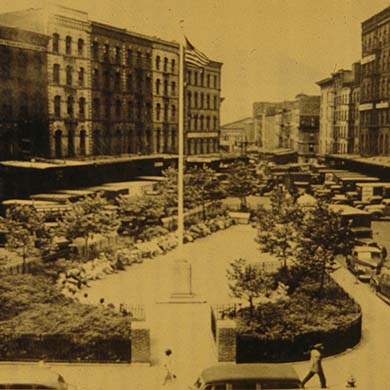
In 1940, the Vaux design was judged old-fashioned and got pretty much scrapped. The area had changed, greenery was hard to maintain in the middle of a warehouse district, and workers wanted benches on which to eat their lunches and have a smoke. Much of the planted area was dug up and paved with concrete, and the ornate cast-iron fence was replaced with a much simpler steel one. In the center of the Hudson St. side, designers added a large flagpole whose outsized base was carved with an inscription to honor the land’s original Dutch owner, Annetje Jans Bogardus. The Hudson St. gate was given imposing brick pillars. All the old trees were cut down and replaced with ten evenly spaced sycamores around the edges. One of them was edited off when the south end of the park was shortened, and another died in 2009 and was replaced the next year.
The Park was never very big, but in fact its edges have been chewed away over the centuries. In the last resizing, in 1954, the western end was lopped off (taking out that tenth tree) and paved as part of Duane St., probably to help cars entering and leaving Staple St., and the sidewalk on the south side was taken away and made a part of the street, probably to increase the back-up area for trucks loading food from butter, pickle, and cheese warehouses. Lacking a sidewalk, the city designers took out the planted area on that side and replaced it with cobblestones, plus a concrete barrier to keep trucks from driving into the trees.
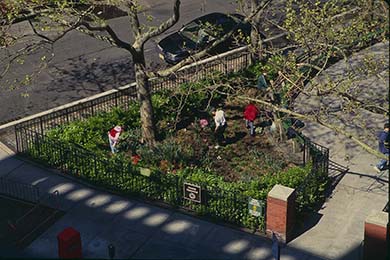
In 1994, as the neighborhood was once again changing and the butter, eggs, pickle, and electrical warehouses were shutting down, a group of neighbors looked at the park with dismay. The city could not keep up with litter, the planted areas were mostly barren and hard-packed, dogs had done their damage, and the design was no longer suitable, either. The Friends of Duane Park was born. Questionnaires poked into every doorway came back with an encouragingly uniform response: fix this eyesore. Fence it, plant it, keep it clean, bring back flowers and greenery, how can we help? Many, many people pitched in, raising money, filling in gaps in the fence, tilling, fertilizing, and planting. The money went for plants, but also for the hiring of an hour-a-day caretaker to stay ahead of the litter. A year later, it looked a lot better, but still had the unsuitable too-much-concrete design from 1940.
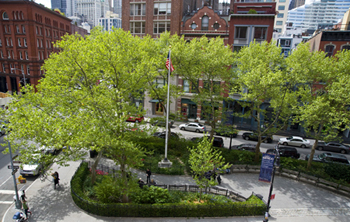
Encouraged by the success of just a year’s work, the Friends set their sights much higher: redesign the park and bring it closer to the Parsons-Vaux ideal of “quiet and restfulness.” In this they were immeasurably aided by neighbor and famed landscape architect Signe Nelson, who spent hundreds of hours developing a design that recalled the best features of the Vaux plan, then shepherded it through many layers of city bureaucracy. Nor could they have done it without help from Council-woman Kathryn Freed, who donated $150,000 from the city’s capital budget, and help from hundreds of contributors and patrons of the Loft Tour. (For amusement, try reading the plaques on the backs of the benches; they represent some of the donors and a few are quite witty, too.) The new park, finished in the late 1990s, might be called the Vaux-Nielsen design. It recovers the secluded and green feeling of 1887, while maintaining a sense of security and providing space for those who like to stop by at lunch hour or sit amid the greenery in the afternoon and evening. Plenty of people eat their breakfast there, too, and in good weather there are always a few children and dogs.
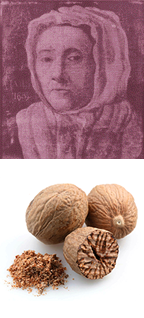
The area around the present park was, like all of Manhattan, loosely occupied by Native Americans, though we know little about their settlements or use of the land. The Dutch and the European idea of land ownership arrived in 1614. In 1636, the Dutch governor, Wouter Van Twiller, granted 62 acres to Roeloff and Annetje Jans as a farm, but Roeloff died the next year. (The 62 acres are almost precisely today’s Tribeca.) Annetje then married the somewhat famous Everardus Bogardus, second minister of the Reformed Dutch Church of New Amsterdam. (Bogardus plays a substantial role in The Island at the Center of the World, an interesting book about the early years of Dutch rule in Manhattan.) The Bogardus family evidently lived on this land, which was renamed Dominie’s Bouwerie, or “The Minister’s Farm.” In 1664 the English seized Manhattan, and in 1667 the Dutch recognized this illegal act, giving Manhattan to the British in exchange for a worldwide monopoly on nutmeg. In 1670 Governor Francis Lovelace bought the farm; in 1672, the Dutch briefly retook Manhattan, but the English got it back in 1674. During that year the Bogardus family does not seem to have tried to re-possess the ancestral farm, which was, in any event, confiscated from Lovelace by the Duke of York, for whom the whole city is named. In 1705 the royal family (by this point, York’s daughter, Anne, was queen) gave the farm to Trinity Church, making it the gigantic landlord of lower Manhattan which it still is today. For the next hundred and fifty years the Bogardus family did try to get it back, unsuccessfully. Thus, it was that “Trinity Lower Farm” owned the tiny chunk of Duane Street that became our park.

We can have only the most general sense of the first peoples of Manhattan. Often and probably too simply lumped together as “Lenape,” or Delaware, they hunted and farmed, and as was their custom, easily shifted from place to place as the land yielded less. They had little sense of ownership of land; viewing themselves as belonging to the land rather than the other way round. Such sensibility made it easier for the acquisitive Europeans to dominate the area, though we have considerable evidence of interaction in the early years. From about 1720 onwards, then, this part of Manhattan was platted and settled by Dutch and then English. The presence of the African Burial Ground on Duane Street itself clearly indicates that from the 17th Century to 1825 there were many enslaved workers here, too. The history of the park, related above, also reflects the shifts in land use and social organization from a picture garden for a prospering residential neighborhood to commercial use that required concrete to dereliction to a renewal that accompanied a wave of innovative artists, musicians, and families that now call the area home.